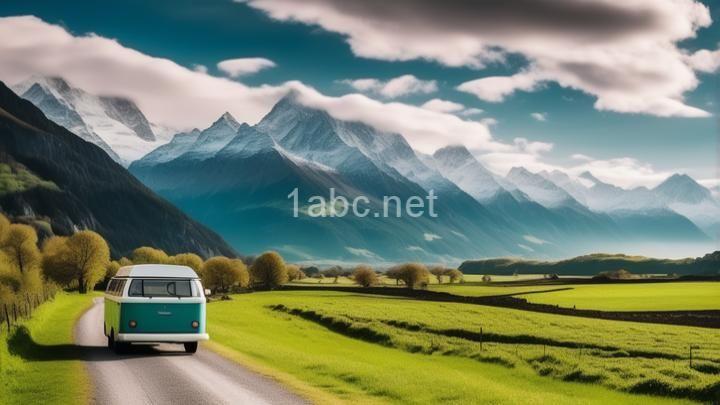The Ultimate Guide to Capturing Stunning Landscapes on Your Travel Photography Journey

Introduction:
Welcome, fellow travel enthusiasts and photography lovers, to the ultimate guide on capturing stunning landscapes on your travel photography journey! In this blog post, we will embark on an exciting adventure together and delve into the art of capturing breathtaking landscapes that will leave you in awe.
There is something truly magical about photographing landscapes. Whether it's the majestic mountains, serene beaches, or vibrant cityscapes, capturing the beauty of nature and the world around us is a truly rewarding experience. These photographs not only serve as a beautiful reminder of our adventures but also allow us to share our experiences with others and inspire them to explore the world.
I. Essential Gear for Landscape Photography
Before we dive into the technical aspects of capturing landscapes, let's talk about the gear you'll need to get started. While it's true that the best camera is the one you have with you, having the right equipment can make a significant difference in the quality of your photographs.
First and foremost, invest in a good camera that allows you to have control over your settings. While smartphones have come a long way in terms of camera capabilities, having a dedicated camera will give you more flexibility and control over your shots. Look for a camera with a high-resolution sensor that can capture details and colors accurately.
In addition to a camera, a good lens is crucial for landscape photography. A wide-angle lens, such as a 14-24mm or 16-35mm, is ideal for capturing expansive scenes and creating a sense of depth in your photographs. These lenses allow you to include more of the scene in your frame and emphasize the scale of the landscape.
Apart from the camera and lens, there are a few additional pieces of equipment that can enhance your landscape photography experience. A sturdy tripod is essential for keeping your camera steady, especially during long exposures or in low light conditions. It allows you to capture sharp images without any camera shake.
Filters are another valuable tool for landscape photographers. A circular polarizing filter helps reduce glare and enhance colors, particularly in scenes with water or foliage. Neutral density filters, on the other hand, allow you to achieve long exposure effects by reducing the amount of light entering the camera.
Lastly, a remote shutter release is useful for minimizing camera shake when shooting on a tripod. It allows you to trigger the camera without physically touching it, ensuring sharp images even with longer shutter speeds.
II. Understanding Composition
Composition plays a crucial role in creating visually pleasing landscape photographs. It is the arrangement of elements within the frame that guides the viewer's eye and creates a sense of balance and harmony.
One popular composition technique in landscape photography is the rule of thirds. Imagine dividing your frame into a 3x3 grid, both horizontally and vertically. The rule of thirds suggests placing key elements of interest along these gridlines or at their intersections. This helps create a sense of balance and visual interest in your photographs.
In addition to the rule of thirds, there are several other compositional techniques you can experiment with to enhance your landscape photographs. Leading lines, for example, draw the viewer's eye into the image and create a sense of depth. Look for natural or man-made lines like roads, rivers, or fences that lead into the scene.
Symmetry is another powerful compositional tool. Look for scenes with reflections or patterns that can be divided equally along the vertical or horizontal axis. Symmetrical compositions can create a sense of calm and harmony in your photographs.
Framing is yet another technique that can add depth and context to your landscape photographs. Look for natural frames like tree branches, archways, or doorways that can surround your subject and draw attention to it. These frames can create a sense of depth and help guide the viewer's eye towards the main subject of your photograph.
III. Mastering Light
Lighting plays a crucial role in landscape photography, and understanding how to work with different lighting conditions can elevate your photographs to a whole new level.
One of the best times to shoot landscapes is during the golden hour, which refers to the hour after sunrise and the hour before sunset. During this time, the sun is low in the sky, casting a warm and soft glow over the landscape. The light is more directional and creates long shadows, adding depth and dimension to your photographs.
Another magical time to shoot landscapes is during the blue hour, which occurs just before sunrise and after sunset. The sky takes on a beautiful blue hue, creating a serene and ethereal atmosphere. This time is perfect for capturing cityscapes or landscapes with artificial lights, as they contrast beautifully against the blue sky.
While shooting during the golden hour and blue hour can yield stunning results, it's important to remember that you can capture beautiful landscapes at any time of the day. Even during midday when the light is harsh and overhead, you can still create striking images by using shadows creatively and finding interesting compositions.
In challenging lighting situations, such as when the sun is high in the sky, you can use accessories like a diffuser or a reflector to soften the light or fill in shadows. Alternatively, you can embrace the strong contrast and play with shadows and highlights to create a dramatic effect in your photographs.
IV. Finding the Perfect Location
Now that you have a good understanding of the technical aspects of landscape photography, let's talk about finding the perfect location for your shoot. Researching potential locations before your trip is essential for maximizing your time and capturing stunning landscapes.
Start by utilizing online resources such as photography websites, forums, and social media platforms. These platforms are filled with valuable information and insights from fellow photographers who have visited the locations you're interested in. Read reviews, look at sample images, and gather as much information as possible to make an informed decision.
Guidebooks are also a great resource for finding hidden gems and off-the-beaten-path locations. These books often provide detailed descriptions, maps, and tips for each location, helping you plan your shoot effectively.
Lastly, don't underestimate the power of local knowledge. Reach out to locals or join photography groups in the area you're visiting. Locals often have insider tips and knowledge about lesser-known locations that can offer unique and stunning landscapes.
V. Preparing for the Shoot
Once you have chosen your location, it's time to prepare for the shoot. Planning ahead and considering various factors can greatly increase your chances of capturing stunning landscapes.
First and foremost, check the weather forecast for the days you'll be shooting. While you can't control the weather, being aware of the conditions can help you plan accordingly. Cloudy or stormy weather, for example, can add drama and mood to your photographs, while clear skies are perfect for capturing vibrant colors during sunrise or sunset.
Tides are another important factor to consider, especially if you're shooting near the coast. High and low tides can dramatically change the landscape and create different opportunities for compositions. Check tide charts and plan your shoot accordingly to make the most of the changing tides.
Additionally, consider the sunrise and sunset times for the location you'll be shooting. These golden hours provide the most beautiful light for landscapes. Arriving early and staying late can often result in the most stunning photographs.
Lastly, don't forget to pack the essentials. Make sure you have extra batteries and memory cards to avoid running out of power or storage space during your shoot. A rain cover or a waterproof bag can also come in handy if you're shooting in unpredictable weather conditions.
VI. Capturing Landscapes with Impact
Now that you're on location and ready to shoot, it's time to explore different perspectives and angles to create unique compositions that will make your landscapes stand out.
Instead of shooting from eye level, try getting down low or finding higher vantage points to create a different perspective. Experiment with different angles and viewpoints to capture the landscape in a way that hasn't been seen before.
Incorporating foreground elements is another technique that can add depth and visual interest to your photographs. Look for interesting rocks, flowers, or other objects that can serve as a foreground element and lead the viewer's eye into the scene. This technique creates a sense of scale and draws the viewer into the photograph.
Don't be afraid to get close to your subject. Sometimes, zooming in on a specific detail or element of the landscape can result in a more impactful photograph. Look for interesting textures, patterns, or colors that can create a striking image.
Lastly, take your time and be patient. Landscape photography is often about waiting for the perfect moment, whether it's the right light, the movement of clouds, or the waves crashing against the shore. Be observant and embrace the serenity of the landscape as you wait for that perfect shot.
VII. Editing Tips for Stunning Landscapes
After a successful shoot, it's time to bring your photographs to life through post-processing. While it's important to remember that editing should enhance your photographs and not completely transform them, a few basic adjustments can take your landscapes to the next level.
Start by importing your images into post-processing software like Adobe Lightroom or Capture One. These programs offer a wide range of tools and adjustments that allow you to fine-tune your photographs.
Begin by adjusting the exposure to ensure that the highlights are not blown out and the shadows have enough detail. Use the histogram as a guide to avoid clipping in the highlights or shadows.
Next, enhance the colors of your landscape by adjusting the white balance, saturation, and vibrance. This allows you to bring out the natural beauty of the scene and make the colors pop.
Sharpening is another crucial step in landscape photography. Use the sharpening tools in your editing software to enhance the details and make your photographs appear crisp and clear. Be careful not to oversharpen, as it can introduce noise and artifacts into your images.
Lastly, don't be afraid to experiment with different editing styles and techniques. Each landscape is unique, and the editing process should reflect the mood and atmosphere you experienced during the shoot. Trust your artistic instincts and have fun exploring different editing possibilities.
Conclusion
Congratulations! You've made it to the end of the ultimate guide to capturing stunning landscapes on your travel photography journey. We've covered essential gear, composition techniques, mastering light, finding the perfect location, preparing for the shoot, capturing landscapes with impact, and editing tips. Armed with this knowledge, you are now ready to embark on your own adventure and capture breathtaking landscapes that will leave a lasting impression.
Remember, landscape photography is not just about capturing beautiful images; it's about immersing yourself in nature, exploring new places, and embracing your creativity. Enjoy the process, be patient, and let your passion for travel and photography guide you. Happy shooting, and may your photographs inspire others to embark on their own travel photography journeys!
FREQUENTLY ASKED QUESTIONS
What is The Ultimate Guide to Capturing Stunning Landscapes on Your Travel Photography Journey?
The Ultimate Guide to Capturing Stunning Landscapes on Your Travel Photography Journey is a comprehensive resource that will help you take your landscape photography to the next level. Whether you're a beginner or an experienced photographer, this guide offers valuable tips and techniques to help you capture breathtaking landscapes during your travels. From selecting the right equipment to mastering composition and lighting, this guide covers all aspects of landscape photography. It provides step-by-step instructions on how to plan your shoots, scout locations, and make the most of different weather conditions.
Additionally, the guide delves into post-processing techniques to enhance your landscape images and make them truly stand out. It covers editing software, filters, and other tools that can help you achieve your desired results.
One of the highlights of this guide is the inclusion of real-life examples and case studies from professional photographers. Their insights and advice will inspire and guide you in your own photography journey.
With its user-friendly format and informative content, The Ultimate Guide to Capturing Stunning Landscapes on Your Travel Photography Journey is a must-have resource for any photographer looking to improve their landscape photography skills. Grab your camera, and get ready to capture stunning landscapes on your next travel adventure!
Who is this guide suitable for?
This guide is suitable for individuals who are seeking casual, empathetic, and formal assistance. Whether you're a beginner or more experienced, this guide caters to a wide range of users. It is particularly helpful for those looking for personalized and informative explanations, as well as a balance between seriousness and humor. So, if you're interested in maintaining a friendly and approachable tone, while still receiving detailed guidance, this guide is perfect for you.
What topics are covered in the guide?
The guide covers a wide range of topics, including skincare routines, makeup application techniques, tips for achieving a natural look, product recommendations, and advice for dealing with specific skin concerns such as acne or dryness. Additionally, it also provides information on how to choose the right foundation shade, properly contour and highlight your features, and create different eye makeup looks. Whether you're a beginner or an experienced makeup enthusiast, this guide has something for everyone!
Are there specific camera requirements for this guide?
There are no specific camera requirements for this guide. You can use any camera that you have available, whether it's a DSLR, mirrorless, or even a smartphone camera. The techniques and tips shared in this guide are applicable to any camera, so feel free to use whatever you're comfortable with. Just make sure to adjust the settings and follow the instructions provided to get the best results.

